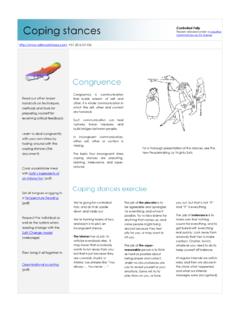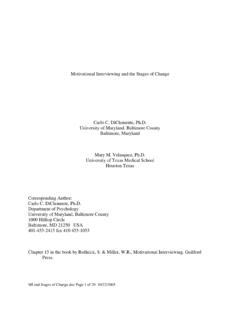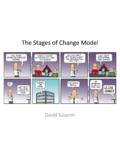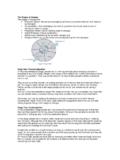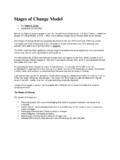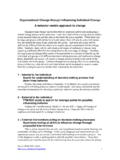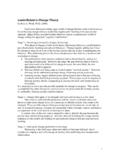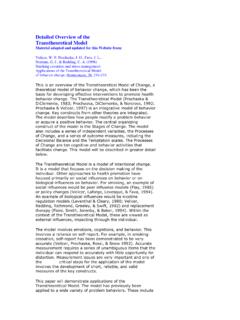Transcription of Satir Change Model
1 Satir Change ModelThe virginia Satir Change Model focuses not juston systems of people but also on individualpeople, making it a robust Model . (Late) Status quoLate status quo describes a fairly stable system(individual or group) where occurrences arepredictable, familiar and comfortable. This maymean things are working reasonably well, or itmay mean that there are familiar solutions(better or worse) for common problems. Formembers, it does represent some level of the system at this stage is balanced,different parts of the system pay different pricesto maintain this balance. This can be compared tothe role played by some children who keep afamily stable by acting out or repressing theirfeelings in particular ways.
2 And, like withchildren, the impact of this maintenance on anyparticular part of the system may be indicated bythe unhealthy symptoms revealed in it'sfunctioning. In an organizational context, late status quogenerally refers to a system where things havestayed the same for a long time. Members of thesystem know 'what to do' and 'how to do it' andunderstand where they fit. They may or may notbe satisfied with their place and activities, butthey are comfortable. Depending on the specific circumstances,attitudes may range from general acceptance, toboredom "yah, I know how to do all that .."to frustration and complaining (blaming andplacating as people find ways to get things donein a dysfunctional system).
3 Some people may belooking for a foreign elementEither from within or without, a foreignelement that was not a part of the status quoappears, and threatens to shake up the an organizational context, a foreignelement can be generated internally, inspiredby the desire to improve. This desire cancome from management or from participantson the operational level; the Change can bemandated or voluntary. How such desires are substantiated by whichstakeholder how, will greatly affect a systemsreaction to the foreign element, although in bothcases there are reactions. In the case of anunwanted, unexpected or mandated Change thepeople within the organization (or other system)may try a number of strategies to neutralize theimpact of the this alien element.
4 The system mayreject and expel the foreign element; membersmay ignore it or use delaying tactics; they may tryto encapsulate the foreign element within the"normal" ways of handling things to make it partof the current state; or they may try to find ascapegoat to attack and blame. When mandated sequences of events areexperienced a couple of times on the operationallevel, trust levels of its people in managementbeing able to lead goes down quickly and peopleanticipate more on potential future managementblaming instead of the by management desiredchanges. Whatever happens, people do learn toanticipate effectively! :-) ChaosIf the foreign element (or its backers) issufficiently powerful and persistent to create acritical mass of discomfort, the organizationenters into chaos.
5 From the Merriam WebsterDictionary:chaos is a state of things in whichchance is supreme; it is a state ofutter confusion; a confused mass ormixture. In this state, the system isdisarranged; predictions no longer1valid, expectations are not fulfilled;things seem to be totally out ofcontrol. People/systems may react to chaos in a numberof different ways: by engaging in randombehavior; by seeking stability at any cost, andtrying to revert to earlier patterns of behavior' orby searching for magical, sweeping solutions --anything to re-establish some form of normalcy. It is very easy to get stuck in chaos: If you see chaos as some "death" of theOld Status Quo.
6 For more detailed"stuckness" we can use the following fourpreliminary stages of death identified byElizabeth Kubler Ross: denial, bargaining,anger, or depression that individuals canget stuck in. When trying to manufacture thetransforming idea as opposed to beingaware and fully present during and firing the latest silverbullet is a distracting temptation, onethat needs to be avoided. Taoists say, "Mybarn having burned to the ground, I cannow see the moon". If you try to avoid or control it. Then youwill prolong it. Best seems to be relax,enjoy the ride, try a bite of somethingnew here, and of some there. Be likeAlice, relax, have fun, enjoy and wait forthe transforming idea.
7 The transforming idea is the out-of-the-box ideathat brings a system out of chaos (sometimes onlyfor a short while ;-). A transforming idea is like an"Aha Erlebnis", inspiration, a sudden awareness ofand understanding of new possibilities. Now thatwe have keys, what remains is finding the doorsand actualizing this and integrationEntering the practice stage, the system begins totry out the new possibilities. This can be likenedto birth or to a honeymoon. It seems all problemshave been resolved and things will be wonderful,and we're all very excited. At the same time,systems entering this stage are like children thatare trying things for the first time -- somewhatuncertain, needing time to learn and grow intothe new state.
8 And, with time, by the systempracticing new ways of doing things, some effectsbegin to appear in substance. In an organization, this is the time when peopleare learning to use a new tool or work accordingto a new process or tasks within a new is usually a period of reduced productivity --performance and outcomes may actually be worsethan prior to the Change . There are many factors that can lead to rejectionof the Change and return to chaos: Reactions of managers who expect to seeresults of the new 'whatever' immediately A culture in which people are afraid toseem less than fully competent and whereadmitting mistakes is not acceptable Time and schedule pressures inhibiting thelearning process.
9 Name it and it can take you back! During integration benefits of the new modelsbecome apparent and are experienced as a new status quo is formed. What beganas an idea becomes a normal state of affairs. And,for a while, things will continue to get better ..until we encounter a new foreign ! This handout is licenced under a CreativeCommons Licence. Its' main memes were launchedby virginia Satir . Brought to you byMarc Evers (Piecemeal Growth) Nynke Fokma (Moebius)Willem van den Ende (Living Software )
